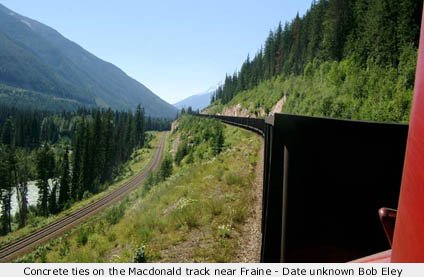Vol. 17 No. 1
January, 1987
|
Keep the Ball Rolling
Stay Safe in 87
|
Concrete Tie
Program Largest
Ever for CP Rail
By Tana Hobbs
|

CP Rail is currently involved in the largest-ever
application of concrete ties on its rail system.
The installation of the new ties is part of the Rogers Pass Project and when the work is completed in two years,
more than 27,000 concrete ties will have been installed over 17 kilometres of surface route.
"The new roadbed being built is designed to be as maintenance-free as possible using the most
advanced technology available", said Peter Holubar, Surface Superintendent, Special Projects.
"Concrete ties were chosen for all surface work because of their extended lifespan, their ability to hold
track alignment longer than conventional ties and because they require less resurfacing (tamping and changing
ballast)".
Sections where the ties are being applied include 15 kilometres between Cupola Creek, near the Rogers pusher
station in the Beaver Valley, and the East Portal of the Mount Shaughnessy Tunnel; the 1.4 kilometres between
the West Portal of Mount Shaughnessy and the East Portal of the Mount Macdonald Tunnel and approximately one
kilometre of track west of the West Portal.
Each concrete tie measures 28.5 centimetres wide at the base and 23.3 centimetres high, weighs 331 kilograms
and costs roughly twice that of a conventional wooden tie.
They are made of pre-stressed concrete with steel reinforcing wires by Genstar Costain Concrete
Tie Company Ltd. of Edmonton, Alberta.
During the first phase of CP Rail's work last fall, Pacific Northern Rail Contractors of Langley, B.C.,
installed more than 19,000 of the ties between the Rogers pusher station and Stoney Creek Bridge. The balance
will be installed in 1987 and 1988.
A concrete tie weighs nearly 225 kilograms more than a wooden tie and heavy machinery is required to install
them.
For the installation, a rubber-tired "CAT-CC12", equipped with a hydraulic
jig, lifts and places seven concrete ties at a time on a prepared roadbed.
Work crews then ensure the ties are exactly 61 centimetres apart when measured from centre to centre.
The spacing is 10 centimetres greater than with the installation of wood ties. Although it does not appear to
be a significant difference, the railway estimates the wider spacing will mean that 5,000 fewer ties will be
required on the surface route.
Continuous welded rail is then laid in 439-metre lengths and thermite welded. Pandrol clips, held
by steel shoulders built into the ties, are used to fasten the rails in place.
CP Rail's decision to use concrete ties follows numerous trials in British Columbia and Ontario.
One such test, on a 800-metre section installed in 1974 at Beavermouth, east of Rogers, B.C.,
demonstrates that concrete ties can hold their own on one of the busiest traffic routes on CP Rail.
More than 600 million gross tons of traffic have passed over the Beavermouth section without concrete tie
failure.
This CP Rail News article is copyright
1987 by the Canadian Pacific Railway and is reprinted here with
their permission. All photographs, logos, and trademarks are the property of the Canadian Pacific Railway
Company.
|
|